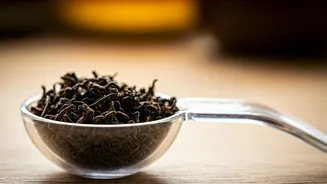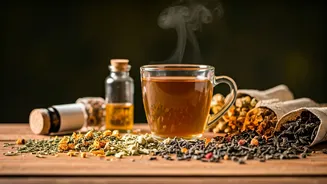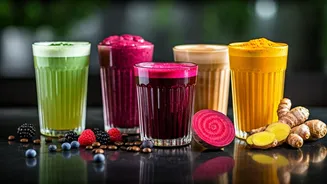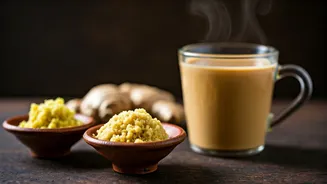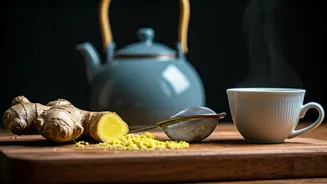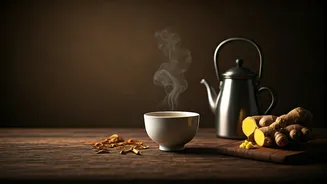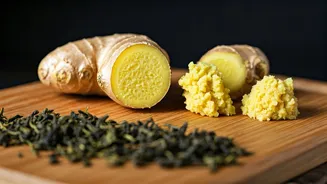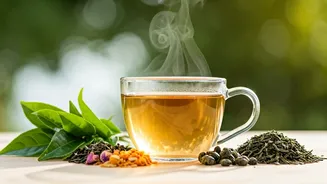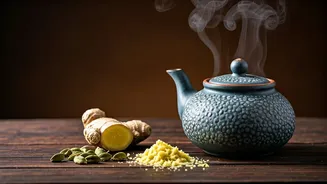Chai Patti's Essence
The essence of a delightful cup of chai is inextricably linked to the 'chai patti,' or tea leaves. These leaves, usually black tea varieties, impart the characteristic
flavor, color, and aroma we associate with chai. Understanding the appropriate quantity of chai patti is pivotal; too little may lead to a weak, bland brew, while excess can result in a bitter, overpowering taste. Beyond taste, the amount of chai patti used can influence the health benefits, as tea leaves contain various compounds with potential positive effects. Careful measurement and consideration of your personal preferences and health goals are vital in mastering the art of chai preparation. The type of chai patti used, the method of brewing, and other ingredients can also affect the final cup, but the amount of tea leaves forms the foundation of a great chai experience.
Benefits in Moderation
When used in moderation, chai patti can contribute to various health benefits. Black tea leaves contain antioxidants, such as flavonoids and polyphenols, known for combating free radicals and protecting cells. These compounds may help reduce the risk of chronic diseases and support overall health. Moderate consumption may also improve mental alertness and focus, owing to the presence of caffeine. The theanine in tea can help promote relaxation and reduce anxiety. However, the precise degree of these benefits relies heavily on the quality of the tea leaves, brewing method, and individual health conditions. It is important to note that excessive consumption can negate these benefits, leading to unwanted effects. Thus, moderation remains the cornerstone of experiencing tea's positive impacts on health and well-being. Always consult with a healthcare professional regarding personalized dietary advice.
Too Much Chai Patti
Overusing chai patti can lead to several undesirable outcomes. The most immediate effect is a bitter and astringent taste, which can ruin the enjoyment of the chai. Furthermore, high concentrations of caffeine present in too much tea can result in increased heart rate, anxiety, and insomnia. Excess caffeine can also cause digestive issues, such as acid reflux or upset stomach. Using too much tea also concentrates tannins, which can interfere with the body's absorption of iron. It is particularly important to be mindful of chai patti quantity if you have underlying health conditions or are sensitive to caffeine. Adjusting the amount of chai patti to the correct ratio, therefore, is crucial not only for taste but also for preventing these adverse effects. Monitoring your body's response is also essential to discover the ideal personal balance.
Ideal Chai Patti Amount
Determining the ideal quantity of chai patti depends on personal preferences and brewing methods. A general guideline is one to two teaspoons of loose-leaf chai patti, or one to two tea bags, per cup (approximately 6-8 ounces) of water. However, stronger or milder concentrations can be achieved by increasing or decreasing the amount. When experimenting, start with a smaller quantity, and gradually add more until you reach your desired taste profile. Brewing time significantly affects strength, as well, so adjusting both tea amount and steep time is advised. The quality of the chai patti itself is also an important factor; higher-grade leaves often have a more robust flavor, requiring less quantity. Consider other ingredients, such as milk, sugar, and spices, which will also impact the overall taste. The perfect chai is a personalized experience, so finding the optimal tea-to-water ratio is the key to mastering your perfect brew.
Taste & Aroma Impact
The correct chai patti amount directly influences the flavor and aroma of the chai. The right balance delivers a rich, full-bodied taste, with a pleasant astringency that isn't overpowering. A slight bitterness should be balanced by the sweetness and creaminess of milk and sugar, as well as the warmth of spices. Aroma is also heavily affected by the tea's concentration. A well-brewed chai emanates a captivating scent, with a layered complexity that invites you to savor the cup. Too little tea results in a muted flavor and weak aroma, while an excess results in harshness and a less appealing scent. Proper measurement also enables you to optimize the potential of your tea blend, releasing its full aromatic and flavorful potential. By mastering the right proportion of chai patti, you are essentially orchestrating the symphony of your chai's sensory experience, making each cup an extraordinary moment.
Perfect Measurement Techniques
Precise measurement is essential for consistently preparing excellent chai. Using a teaspoon or measuring spoon is the most accurate method for loose-leaf tea. For tea bags, using one tea bag per cup offers a convenient way to achieve the proper concentration. A kitchen scale can also be helpful for weighing the tea leaves, particularly when experimenting with different blends and tea-to-water ratios. Always measure the chai patti before adding water, and be consistent in your measurements. If you prefer a stronger brew, you can gradually increase the tea amount and adjust the brewing time. For a milder taste, decrease the amount of tea and/or the steep time. Taking detailed notes on the amounts and adjustments helps with replicating perfect cups in the future. The more you experiment, the better you will understand the nuances of the chai patti and perfect your technique.
